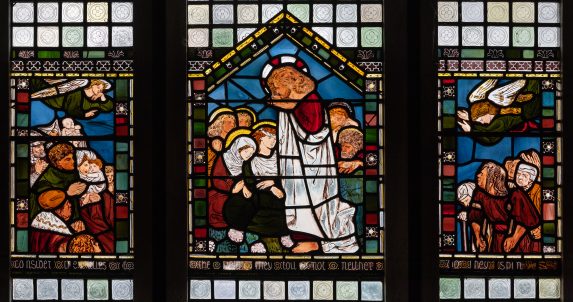Church of All Saints, Selsley, Gloucestershire
Address
Church of All Saints, Pooles Lane, Selsley, Stroud GL5 5LERecommended by
Highlight
Sermon on the Mount window, south aisle, third window from westArtist, maker and date
Designed by Dante Gabriel Rossetti for Morris, Marshall, Faulkner & Co., 1862Reason for highlighting
This is just one window of the first full glazing scheme by Morris, Marshall, Faulkner and Co., in 1862, for their friend G. F. Bodley’s church at Selsley, near Stroud. Like the paintings that Rossetti and the other Pre-Raphaelites and their associates had been doing since the 1840s, this particular window is full of portraits. The lion-maned Christ is the author George Meredith, and you can find other portraits in the window that seem a humorous – in Rossetti’s rather biting way – commentary from the artist. His sister Christina is probably the sorrowing Virgin Mary, but his mistress Fanny Cornforth is Mary Magdalene – and can you spot the 28-year-old William Morris as a hoary-headed old St. Peter? In the background are poet Charles Swinburne as St. John and artist – and stained-glass designer himself – Simeon Solomon as St. James. Judas, behind St Peter, is modelled on Ernest Gambart, the picture dealer, who Rossetti did not like. Above in a small rose that echoes the west rose window, is one of Rossetti’s alluring angels, drawn with great freedom and with a come-hither look in her eye! The naturalistic style of Rossetti and his friends and the earthly colourways chosen by Morris and Webb are a definite departure from the deliberately medievalising figures and colourways used by most of the other firms at this time. It shows the difference that employing a practicing fine artist could make to the style of stained glass, and many of the larger firms would or already were following suit.
Artist/maker notes
Morris, Marshall, Faulkner & Co. (1861-74) or ‘the Firm’, as it was colloquially referred to, was founded in 1861 by William Morris, Edward Burne-Jones, Dante Gabriel Rossetti, Ford Madox Brown, Philip Webb, Peter Paul Marshall and Charles J Faulkner. ‘The Firm’ and its later iteration, Morris & Co., would go on to create some of the most influential stained glass of the 19th century, creating new aesthetics and themes that artists in both the Arts and Crafts Movement and the big glass companies would learn from.
It was an artists’ collective born of Morris and his friends’ enthusiasm for decorating his new marital home, Red House in Bexleyheath, near London, designed by Philip Webb. Morris was quite arrogant about his ambitions for design in churches, saying, ‘You see we are, or consider ourselves to be, the only really artistic firm of the kind, the others being only glass painters in point of fact, or else that curious nondescript mixture of clerical tailor and decorator that flourishes in Southampton Street, Strand; whereas we shall do — most things.’
Stained glass became one of the main stays of the company, with most designs by Burne-Jones, and, later by the 1890s and after Morris and Burne-Jones’ deaths, John Henry Dearle, the Firm’s chief designer.
Sources:
For a brief overview see Morris & Co on Wikipedia
Angels and Icons: Pre-Raphaelite Stained Glass by William Waters and Alistair Carew-Cox (Seraphim Press, 2012)
Burne-Jones Special Issue, The Journal of Stained Glass, Vol. XXXV, 2011
Damozels & Deities Pre-Raphaelite Stained Glass 1870-1898 by William Waters and Alastair Carew-Cox (Seraphim Press Ltd, 2017)
Morris stained glass: ‘an art of the Middle Ages’ by David O’Connor in William Morris and the Middle Ages ed. Joanna Banham and Jennifer Harris (Manchester University Press, 1984)
The Last Pre-Raphaelite: Edward Burne-Jones and the Victorian Imagination by Fiona McCarthy, Faber & Faber, 2011.
The Stained Glass of William Morris and his circle by A Charles Sewter (Yale University Press, 1974)
William Morris: A Life for Our Time by Fiona MacCarthy (Faber & Faber, 1994)



Other comments
The glazing scheme is based on the early fourteenth century model of Merton College Chapel in Oxford, which Webb, Morris and Edward Burne-Jones all knew well. Webb designed the overall scheme, and contributed the animals, but several different artists took part – Morris himself, showing he was actually no slouch at figure work, Burne-Jones and Ford Madox Brown alongside Rossetti – all in their subtly differing styles. Only Burne-Jones and Madox Brown had had experience in designing for stained glass before, making the whole a remarkable accomplishment. One of their glass painters, George Campfield, also produced designs for the church, used under the rose window. His designs are noticeably more stylised and medieval-looking.
Architect G F Bodley was making something of a leap of faith when he employed his friends in Morris, Marshall, Faulkner and Co. to complete this, their first full glazing scheme. The company had only been founded the year before. The glass designed by the Firm even at this early date marks a sea change away from the medievalising styles of companies like Clayton and Bell despite their inspiration from medieval glass.